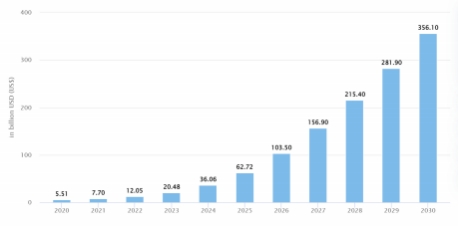
Global Computing Power Enters a New Era of Rapid Development
Benefiting from the rapid economic recovery, the global server market continues to grow. In terms of complete systems, the global server market in 2021 recorded a shipment volume of 13.5339 million units and a total sales revenue of $99.22 billion, representing a year-on-year growth of 6.9% and 6.4%, respectively. HPE/H3C led the global server market with a 15.6% market share, followed by Dell, Inspur, Lenovo, and Huawei with 15.4%, 8.9%, 6.4%, and 1.9% market shares, respectively.
In the chipset segment, the server chipset market has long been dominated by the X86 architecture, with Intel and AMD holding 81% and 16% of the market share, respectively. As Intel's dominance in the server field weakens, AMD’s market share is expected to continue to rise. Additionally, ARM server chipsets are gradually emerging, with global giants such as Nvidia, Amazon, Huawei, and Alibaba launching their own ARM server CPUs. The market share of ARM servers is projected to steadily increase and is expected to reach 10% by 2024, becoming an important supplementary force for general-purpose computing power.
The increasing scale of training data and the rising complexity of models are driving the rapid growth in demand for AI servers. According to IDC statistics, the global AI server market reached $15.6 billion in 2021, representing a 39.1% year-on-year growth. This growth outpaced the overall AI market (including hardware, software, and services), which grew by 22.5%, making AI servers a key driver of growth for the entire AI market.

In the 2021 global AI server market, Inspur, Dell, and HPE ranked as the top three vendors with market shares of 20.9%, 13.0%, and 9.2%, respectively, collectively accounting for 43.1% of the market. Huawei (5.8%) and IBM (4.1%) ranked fourth and fifth, respectively.
On the chipset front, traditional chip giants are accelerating the improvement of their AI chip product ecosystems, striving to enhance computing capabilities and dominate the diverse computing power landscape. Intel introduced its next-generation high-performance deep-learning AI training processor, Habana Gaudi2, which delivers twice the computing speed of its predecessor. After acquiring Xilinx, AMD plans to integrate Xilinx's FPGA AI engine into its CPUs. NVIDIA launched its new GPU architecture, featuring TSMC's 4nm process and integrating 80 billion transistors, significantly enhancing AI computing performance.
The Exascale supercomputing era has arrived, with supercomputing equipment manufacturers accelerating industrialization efforts, particularly TSMC. In the TOP500 list of supercomputers, Lenovo led the market with 161 supercomputers, representing 32.2% of the global total. HPE ranked second with 96 supercomputers, accounting for 19.2%. Inspur, Atos, and Sugon ranked third to fifth with 50, 42, and 36 supercomputers, respectively, representing 10%, 8.4%, and 7.2% of the market.
HPE introduced the Exascale supercomputer Frontier, the first Exascale system launched after HPE's $1.3 billion acquisition of Cray, which is expected to surpass 2 EFlops in performance by 2023. Atos unveiled its new supercomputer, BullSequana XH3000, capable of achieving Exascale traditional numerical simulation and 10-Exascale AI-accelerated computing.
In terms of chips, Intel and AMD CPUs continue to dominate. Among the TOP500 supercomputers, 388 systems use Intel CPUs, accounting for 77.6%, while 93 systems use AMD processors. Additionally, the application of heterogeneous computing chips in supercomputers is increasing. Among the TOP500 systems, 168 supercomputers employ accelerator/co-processor technologies, of which 154 systems use NVIDIA chips, and 8 systems use AMD chips.
Last updated